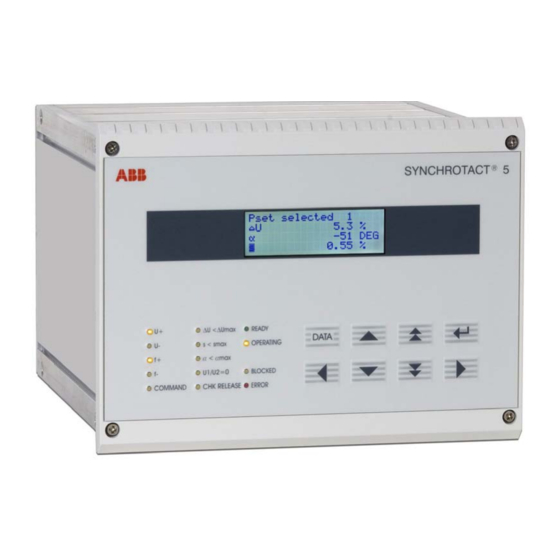
Summarization of Contents
1 General information
1.1 Introduction
Provides an overview of the manual and its target audience.
1.2 Marking of text sections
Explains symbols and text conventions used in the document.
1.3 Purpose and use of the SYN 5201 and SYN 5202
Details the applications and functions of the SYNCHROTACT 5 device.
1.4 Manufacturer’s address
Provides contact information for ABB Switzerland Ltd.
2 Functional principle
2.1 Brief description
Gives a high-level overview of the SYNCHROTACT 5 digital synchronizer.
2.2 Paralleling functions
Describes the four main functional blocks of the automatic paralleling process.
2.2.1 Measuring
Details the variables measured and generated by the device.
2.2.2 Voltage and frequency matching
Explains the working range and methods for voltage and frequency matching.
2.2.3 Monitoring of paralleling conditions
Covers conditions for paralleling voltage-carrying and no-voltage lines.
2.2.4 Command generation
Explains command generation for asynchronous and synchronous sources.
2.3 Test functions
Describes three test functions for matching the device to the installation.
2.4 Operating statuses, operating modes and sequences of the synchronization process
Details the device's operating statuses, modes, and synchronization sequences.
2.5 Self-monitoring of the synchronizer
Outlines the device's internal monitoring functions for hardware and software.
2.6 Stored data
Describes the storage of parameter values and event logger data.
2.7 Time synchronization
Explains methods for synchronizing the device's internal clock.
2.8 Control options
Details service and operating control methods for the device.
2.9 Transmitted signals via interfaces
Describes signals transmitted via service and operating interfaces.
3 Hardware construction
3.1 Type code for devices
Explains the structure and meaning of the device type code.
3.2 Front panel
Describes the front panel layout, including status displays and keys.
3.3 Rear of unit
Details the electrical connections made on the rear of the unit.
3.4 Printed circuit boards
Lists and describes the different printed circuit board modules.
4 Parameters, Actual values, Events
4.1 Overview
Provides a general overview of parameters, actual values, and events.
4.2 Parameter settings
Details all configurable parameters grouped by function.
4.3 Addressing and configuration of the operating interface
Explains addressing and configuration for Modbus RTU, Profibus DP, Lon-Bus, and IEC 61850.
5 Engineering instructions
5.1 General advice
Provides general recommendations for installation and wiring.
5.2 Connection of the measuring voltages
Explains voltage connection and phase-angle difference compensation.
5.3 Sequences of the synchronizing process
Describes the step-by-step sequences for initiating synchronization.
5.4 Configurable I/Os
Explains how to assign parameter sets and paralleling points to I/Os.
5.5 Use of the automatic synchronizing device as synchrocheck
Details parameter settings for using the device as a synchrocheck.
5.6 Communication
Describes service and operating interfaces for communication.
5.7 Time synchronization
Explains methods for synchronizing the device's internal clock.
6 Installation and disposal
6.1 Diagram of dimensions
Provides dimensional drawings for device installation.
6.2 Fixing
Describes the procedure for physically mounting the device.
6.3 Earthing and wiring
Details earthing requirements and cable connection recommendations.
6.4 Disposal
Provides guidance on the environmentally sound disposal of the device.
7 Operating instructions
7.1 Operation for commissioning and maintenance purposes
Explains commands and display functions for maintenance.
7.2 Control for commissioning and maintenance using the PC tool SynView
Details PC-based control and connection procedures using SynView.
7.3 Operational control
Describes how to control the device during normal operation.
7.4 Operation via IEC 61850 - interface
Explains operation and configuration using the IEC 61850 interface.
8 Commissioning
8.1 Warnings and instructions
Highlights safety precautions and essential instructions for commissioning.
8.2 Work carried out with the machine at a standstill
Covers checks and adjustments performed before the machine is running.
8.3 Work carried out while the machine is running
Details tasks performed while the machine is in operation, including matcher adjustments.
9 Maintenance and faults
9.1 Maintenance
States that the device requires no specific maintenance.
9.2 Faults
Covers general fault information and troubleshooting procedures.
9.3 Faults in connection with a communication interface
Provides troubleshooting steps for communication interface issues.
10 Technical data
10.1 Inputs
Specifies technical details for the device's various input types.
10.2 Outputs
Specifies technical details for the device's various output types.
10.3 Interfaces
Details the specifications for service, time sync, and operating interfaces.
10.4 Transmission values
Lists the measuring ranges and accuracy specifications for the device.
10.5 Environmental values
Details climatic, mechanical, and interference immunity specifications.
10.6 Relevant standards
Lists applicable CE conformity and product standards.
10.7 Construction data
Provides information on protection type, weight, and installation altitude.
12 Record and questionnaire
12.1 Settings record for SYNCHROTACT 5
Provides a template for recording device settings and commissioning details.
















Need help?
Do you have a question about the SYNCHROTACT 5 and is the answer not in the manual?
Questions and answers